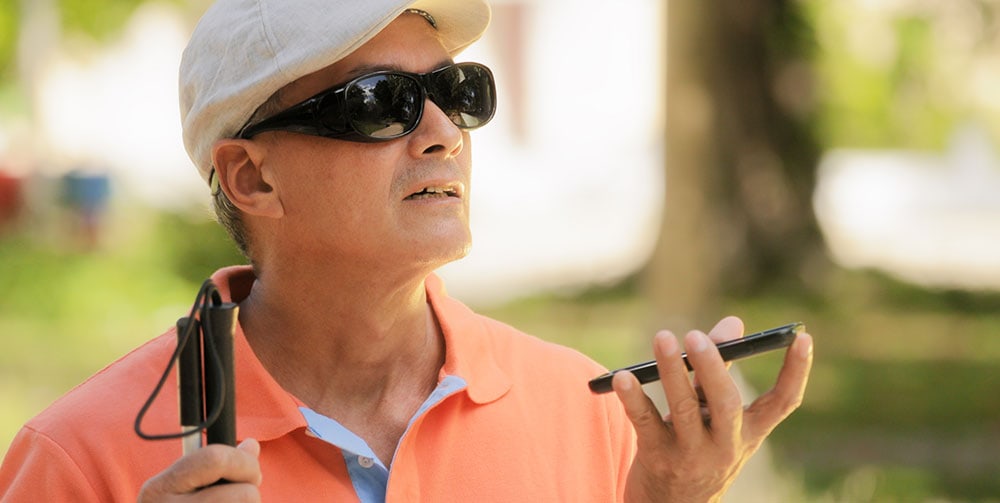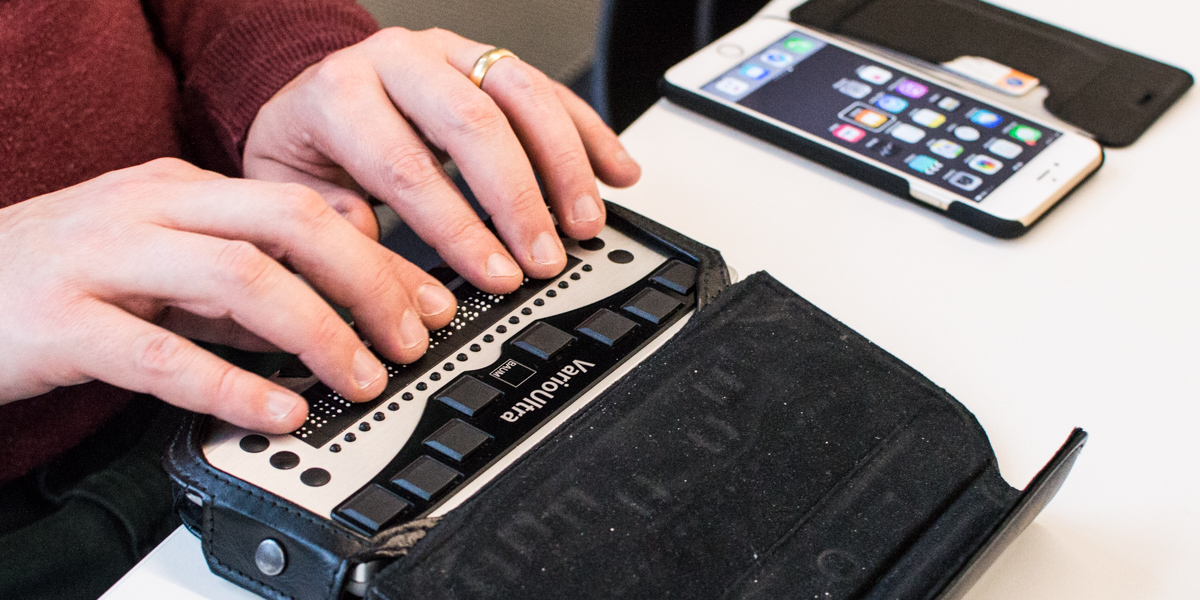Discover Innovative Tools Designed for the Aesthetically Impaired
The advancement of cutting-edge devices for the visually damaged represents a substantial development in ease of access and independence. Technologies such as clever glasses with AI capabilities and mobile applications designed to give auditory summaries are reshaping day-to-day experiences for individuals.
Smart Glasses for Navigation

Smart glasses created for navigation are transforming the means aesthetically impaired people engage with their environment. These sophisticated gadgets utilize a combination of cam technology, artificial knowledge, and acoustic feedback to give real-time details about surroundings. By using challenge detection systems, clever glasses can notify individuals to prospective risks, making it possible for much safer movement in both unfamiliar and acquainted settings.
The integration of GPS innovation even more boosts navigating capacities, enabling customers to get auditory directions as they relocate. This hands-free approach not just fosters freedom however additionally empowers visually damaged individuals to browse urban landscapes with boosted confidence. Furthermore, several smart glasses are equipped with features that determine spots and street indicators, providing contextual details that enhances the individual experience.
In addition, the growth of these gadgets is continually progressing, with firms working to enhance the precision of object acknowledgment and increase the range of navigational attributes. As wise glasses come to be much more obtainable and affordable, they hold the potential to substantially change every day life for visually impaired users. Eventually, these cutting-edge devices represent an essential step toward inclusivity, offering improved mobility and a better sense of autonomy for individuals navigating the world around them.
Mobile Application for Daily Living
How can mobile applications boost the daily lives of aesthetically damaged people? Mobile applications are reinventing the means visually damaged customers browse their atmospheres, take care of daily tasks, and accessibility information. These applications offer vital assistance through different capabilities, fostering self-reliance and boosting high quality of life.
Several innovative mobile apps are made specifically for daily living. For example, applications like Be My Eyes attach aesthetically damaged customers with sighted volunteers using video phone calls, enabling them to receive real-time support with jobs such as reviewing labels or navigating unfamiliar areas. Seeing AI, established by Microsoft, utilizes synthetic knowledge to explain surroundings, read message, and recognize objects, successfully transforming a smartphone into a powerful device for day-to-day aid.
In addition, navigation applications tailored for the visually impaired, such as Aira and BlindSquare, supply audio-based instructions and environmental details, enabling individuals to traverse their environments safely and with confidence. Beyond navigation and immediate support, mobile apps also sustain organization and job administration, with attributes that assist customers set suggestions, develop to-do listings, and track visits. In summary, mobile applications act as indispensable resources, empowering aesthetically damaged individuals to lead more independent and fulfilling lives.
Wearable Technologies for Aid
Empowerment via modern technology is increasingly evident in the world of wearable tools designed to aid aesthetically damaged people. These innovative devices incorporate perfectly into every day life, boosting navigation and giving important responses to individuals. Wise glasses geared up with cameras can check out and identify faces message aloud, allowing individuals to interact even more confidently in expert and social setups.
Another noteworthy development is using haptic responses systems in wearable gadgets. These systems use spectacle frames vibrations or other responsive signals to share info regarding the user's environment, such as obstacles or adjustments in surface, enhancing movement and safety and security. Wearable innovations also include wristbands that attach to mobile phones, notifying individuals to notifications with refined resonances, hence improving connection without dependence on visual hints.
As these modern technologies remain to develop, they are not only improving independence for visually damaged individuals however likewise promoting a greater sense of inclusion in society. By linking the void in between obstacles dealt with in everyday living and the possibility for freedom, wearable technologies work as crucial devices in the mission for equality and empowerment for those with aesthetic problems.
Sound Summary Tools
Sound summary tools play a vital function in boosting access for aesthetically damaged individuals, providing them with the more helpful hints capacity to involve with visual media. Mobility aids for visually impaired users. These devices provide narrated descriptions of crucial visual components in movies, television shows, and live performances, guaranteeing that users can completely comprehend the context and emotions shared via visuals
Audio summary can be integrated into different platforms, including streaming solutions, movie theater screenings, and live cinema. Lots of popular streaming services now include audio description as an ease of access attribute, allowing visitors to select it easily. Along with traditional media, specialized apps likewise exist, giving audio summaries for art exhibitions, museums, and other cultural occasions.
The effectiveness of audio description hinges on the skill of the narrators, that should share visual information succinctly without taking away from the original sound. Developments in this area are likewise leading the way for even more customized experiences, where individuals can readjust the level of detail and pacing according to their choices.
Braille Innovations and Gadgets
Braille tools and technologies have actually substantially transformed the means visually damaged people interact with text and information. Modern improvements have brought about the advancement of versatile tools that improve literacy and these details self-reliance among customers. Notably, Braille present innovations have actually developed, permitting vibrant reading experiences. These tools convert electronic text into Braille, making it possible for individuals to access a vast variety of information on smartphones, tablets, and computer systems.
In addition, portable Braille notetakers combine typical Braille input with modern performances, promoting note-taking, organizing, and document editing on the go. Braille displays and notetakers. These small tools frequently feature text-to-speech capabilities, bridging the gap between Braille and acoustic information
In addition, innovative Braille printers have emerged, permitting customers to generate Braille tags, documents, and educational products successfully. This access cultivates higher involvement in professional and educational settings, inevitably promoting inclusivity.
Additionally, research into smart Braille technologies proceeds to broaden. Gadgets that incorporate artificial knowledge are being discovered to give real-time navigating support and contextual details, boosting the individual experience in diverse settings. Overall, these advancements show a commitment to equipping visually damaged people with innovation, ensuring they can conveniently gain access to and engage with the globe around them.

Conclusion
The development of ingenious tools for the visually damaged dramatically enhances independence and high quality of life. Smart glasses, mobile applications, wearable innovations, audio summary tools, and Braille innovations jointly encourage people by supplying crucial navigating help, environmental awareness, and boosted analysis experiences. These innovations not only foster greater addition yet likewise advertise freedom in daily activities, ultimately adding to an extra fair and obtainable society for visually damaged people. Continued growth in this field holds promise for more enhancements.
As smart glasses come to be much more obtainable and cost effective, they hold the potential to substantially change everyday life for aesthetically impaired individuals. Mobile applications are transforming the method visually damaged customers navigate their environments, manage everyday jobs, and access info. Applications like Be My Eyes attach visually damaged users with sighted volunteers by means of video clip telephone calls, allowing them to get real-time help with jobs such as reading tags or navigating strange rooms.Furthermore, navigating apps tailored for the visually impaired, such as Aira and BlindSquare, provide audio-based directions and ecological information, allowing individuals to traverse their environments securely and with confidence.The innovation of innovative tools for the visually impaired substantially improves freedom and top quality of life.